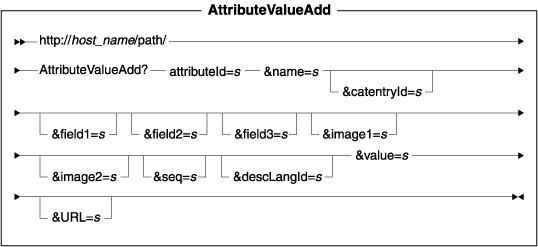Reference > Shop flow URLs > Catalog subsystem URLs > Attributes
AttributeValueAdd URL
This URL adds a new attribute value to an existing catalog entry.
Restriction: This URL must only be used for defining attributes. Descriptive attributes are not supported.
URL structure
- http:// host_name/path/
- The fully qualified name of the WebSphere Commerce Server and the configuration path.
 name-value pair with the &
character. For a detailed description of the parameters and their values, see the list entitled Parameter values." />
name-value pair with the &
character. For a detailed description of the parameters and their values, see the list entitled Parameter values." />
Parameter values
- attributeId
- Required: The reference number of the attribute.
- name
- Required: The name of the attribute value. If you do not specify the name, then the value of the attribute value will be used as the name.
- catentryId
- The reference number of the catalog entry. If the catalog entry ID is not supplied, then the attribute value will be assigned to catentryId = 0, meaning that it is a product attribute value.
- field1
- A customizable field.
- field2
- A customizable field.
- field3
- A customizable field.
- image1
- An image path for this attribute value.
- image2
- An image path for this attribute value.
- seq
- The sequence determining the display order of the attribute value for a given attribute.
- descLangId
- The description of the language's reference number. If you do not specify the language reference ID, the language ID from the WebSphere Commerce Accelerator log on is used.
- value
- Required: The value of the attribute value.
- URL
- The redirect URL.
Example 1
The following example adds an attribute value, with value 1 as the type and testattribute as the name, to the catalog entry 10001 and attribute 10001:
http://host_name/webapp/wcs/stores/servlet/AttributeValueAdd? catentryId=10001&attributeId=10001&descLangId=-1&field1 =0&field2=field2&field3=field3&image1=image1.gif& image2=image2.gif&name=testattribute value&value=1&URL= LogonForm
Example 2
The following example adds attribute value 12345 to product attribute 10002:
http://host_name/webapp/wcs/stores/servlet/AttributeValueAdd? attributeId=10002&value=12345&sequence=0&field1=1& field2=field2&field3=field3&image1=image1.gif&image2= image2.gif&URL=LogonForm
Example 3
The following example adds a product attribute, with testattribute as the name, to attribute 10004. The assigned float value is 2.2, the integer value is 1, and the string value is string. Depending on the type of attribute (string, float, or integer), the corresponding value will be used as the value for the attribute value:
http://host_name/webapp/wcs/stores/servlet/AttributeValueAdd? attributeId=10004&sequence=0&field1=0&field2=field2& field3=field3&floatValue=2.2&image1=image1.gif&image2= image2.gif&integerValue=1&name=test attribute&stringValue= string&URL=LogonForm
Behavior
- This URL creates an attribute value based on the given parameter, either a product attribute value or an item attribute value. However, it is recommend that you use the AttributeValueUpdate when
creating an item attribute value.
- If cagtentryId is not supplied, then the attribute value will
be assigned as catentryId=0, which identifies a product attribute
value.
- The integerValue, floatValue, and stringValue parameters are optional, as long as the value parameter is provided.
- If descLangId is not supplied, then the logon language ID will be used
Exception conditions
The attribute value type should be different than the attribute type.
Before creating an attribute value for an item attribute, first create the product attribute value. For example, if the attribute is "Color", create the values, such as "Red", "Blue", and "Yellow" for the product attribute value first.
Related concepts
Related reference